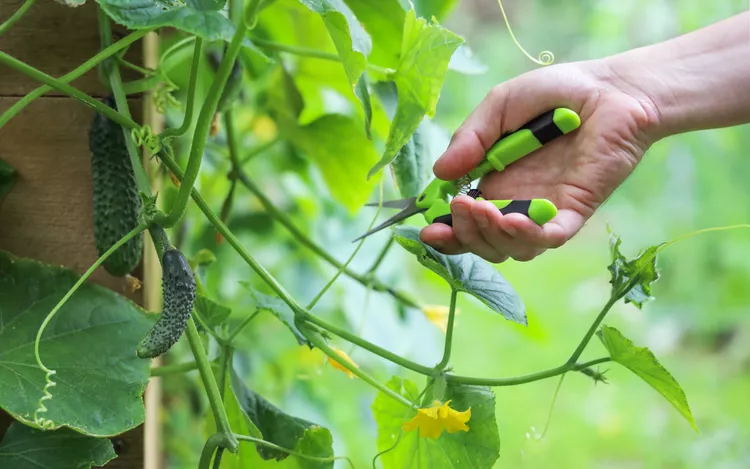Pruning cucumber plants at the right times can make all the difference between a poor harvest and a bumper crop of homegrown cucumbers. If you haven’t pruned cucumbers before, you might not know where to start. This simple guide on how to prune cucumber plants will answer all your questions.
Why should you prune cucumbers?
One of the main reasons growers prune cucumbers is that it makes vines easier to trellis on support systems. However, other benefits of pruning cucumber plants include:
- More manageable plants. Pruning vining cucumbers prevents them from spreading aggressively and makes the plants much easier to maintain. Pruning keeps your garden looking tidy and allows nearby companion plants to thrive as well.
- Space savings. Growing cucumbers vertically on trellises is a great way to fit cucumbers in a small garden space. Pruned cucumbers are much easier to trellis.
- Reduced diseases. Removing extra cucumber leaves improves airflow and reduces the risk of diseases like powdery mildew.
- Earlier ripening. Pruning cucumber suckers funnels the plant’s energy toward its fruit instead of leafy growth, which can result in an earlier harvest. Topping the cucumber plants is particularly useful as the end of the season nears.
- Larger fruit. Just as pruning helps cucumbers ripen earlier, pruning can also boost the size of cucumber fruit. Plucking away some of the plant’s leaves and extra cucumbers redirects the plant’s energy toward the remaining cucumbers.
- Easier harvesting. Dense vines make it hard to spot cucumbers until they’re overripe and turn a bright yellow color. If you prune some of the plant’s leaves, it’s much easier to see cucumbers and harvest them at the peak of freshness.
- More productive plants. Pruning cucumbers helps your plants produce more prolifically too. By removing extra leaves, your cucumber vines can focus their energy on growing more cucumbers.
When to Prune Cucumbers
Pruning cucumbers isn’t a one-time activity. Instead, prune the plants regularly throughout the growing season for the most benefits. How often you need to prune vining cucumbers depends on how fast your plants grow, but plan on at least once every one to two weeks.
Cucumber Pruning Tips
These tips work best on trellised vining cucumbers but also apply to vining cucumbers on the ground.
1. Don’t prune too early.
While you might be tempted to start pruning your cucumber plants right away, hold that thought. Pruning cucumbers too early limits the size of the vines and reduces fruit production. Instead, wait to prune cucumber vines until they are about three to five weeks old and measure 1 to 2 feet high.
2. Disinfect your tools.
To avoid spreading plant diseases when pruning, disinfect your pruning tools between plants with isopropyl alcohol.
3. Find the plant’s main stem.
When you’re ready to prune the plants, inspect the vines carefully. You should notice that cucumber plants consist of one main stem and multiple branching stems or clusters of leaves that extend away from the main vine. Don't prune the main stem of cucumber vines, as this can halt the plant’s growth.
4. Remove the lower lateral stems and leaves.
Clip away the lowest four to six lateral stems around the base of the cucumber vine. These lateral stems, also known as suckers, can draw energy away from the plant’s main stem. Removing the lowest stems helps the cucumber vine maintain a vertical growth habit on your trellising system.
5. Remove any damaged or diseased leaves.
After removing the lowest suckers from the vines, inspect your cucumber plant for any damaged, yellow, or diseased leaves and cut them away. Diseases, like powdery mildew, can rapidly spread throughout a plant, but you can limit this by removing any diseased plant tissue. It’s also a good idea to snip off any leaves near the soil line as they are more likely to develop diseases due to poor airflow and rain splashing soil-borne pathogens onto them.
6. Snip away extra suckers.
Next, inspect the plant for additional suckers, which often appear in the crook between the plant’s main vine and some leaves. Suckers are usually recognized by their bushy appearance and small leaves. If you’re growing field cucumbers that aren’t self-fertile, you don’t want to remove all the suckers, but cutting off some suckers can redirect your plant’s energy toward fruit development.
Pinch away young suckers with your fingers, but cut older branches with sharp pruners at a 45-degree angle to avoid damaging the plant. You’ll want to remove the suckers around the bottom of the plant, but leave at least two to three suckers at the top section of the vine. These suckers can branch and fruit and are usually productive because the top of the plant receives lots of sunlight.
7. Stay on top of pruning and harvesting.
After the initial pruning, check the cucumber vine at least once a week for additional suckers, and snip away new lateral stems as they appear. Cucumbers grow rapidly in spring and summer, and they can produce many suckers in a short period. Staying on top of pruning and pinching off suckers when they’re still small keeps the plants tidy and productive throughout the season.
As the cucumbers grow, continue to remove any damaged plant leaves and be sure to harvest cucumbers as soon as they ripen. Leaving cucumbers on the plant too long can sap the vines of energy and reduce your harvest.
8. Top your plant at the end of the season.
You may want to “top” your cucumber vine at the end of the growing season to encourage the remaining fruit to ripen faster. This pruning technique is also useful for tomatoes, and it’s particularly effective if there’s cold weather in the forecast and you want your cucumbers to ripen before frost arrives.
To top the plant, cut off the top of the main stem with your pruners. This encourages the plant to focus its energy on the fruit remaining on the vine.




















